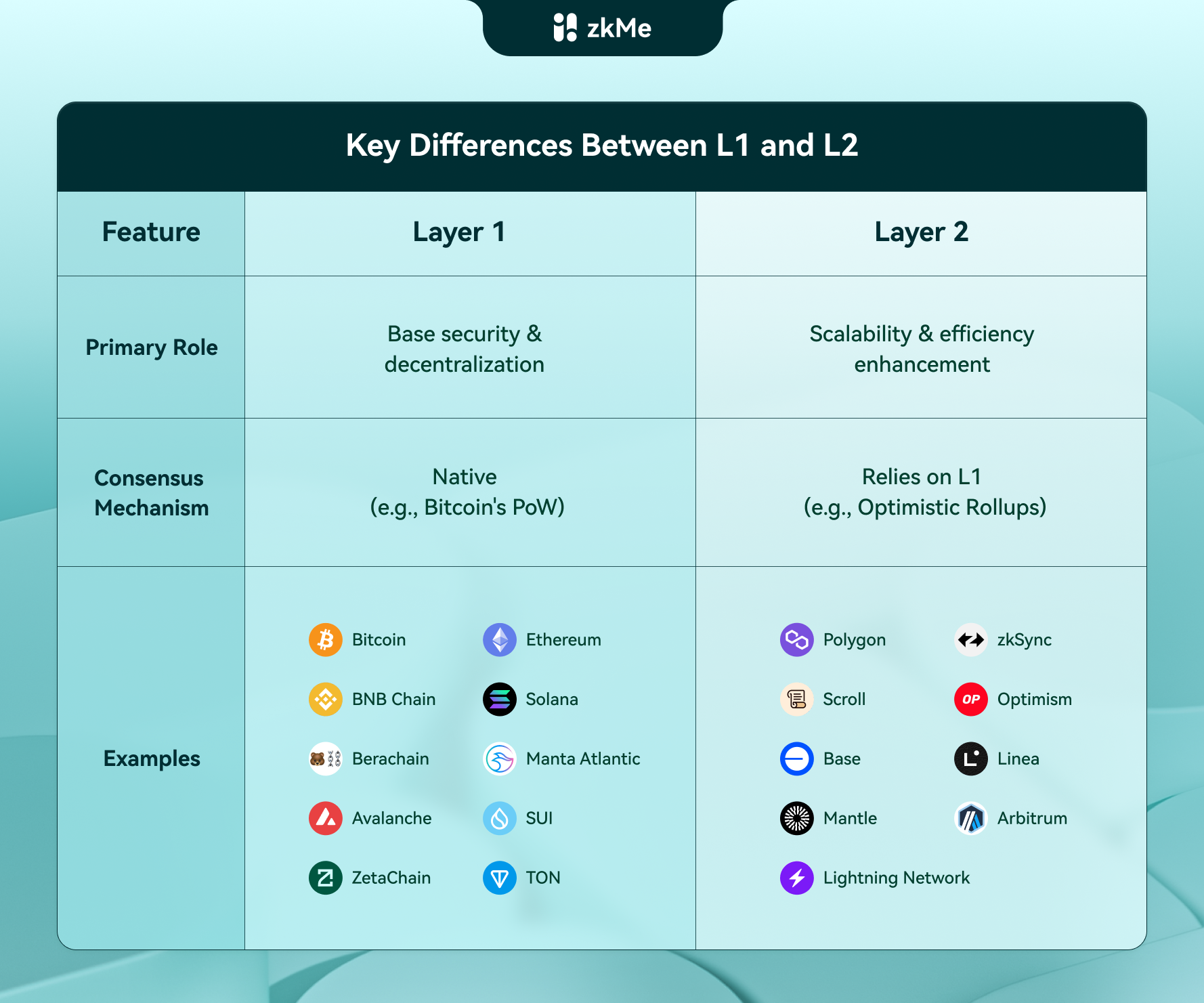In the rapidly evolving development of blockchain technology, we often hear the terms L1 and L2. As the first piece in our educational Blockchain 101 Series, today we'll explain these two concepts in simple terms, unveiling the mystery of blockchain's layered architecture.
What are L1 and L2?
Layer 1 and Layer 2 solutions complement each other in the blockchain ecosystem, helping to solve the fundamental challenge of achieving decentralization, security, and scalability simultaneously.Layer 1 (L1) refers to the base blockchain protocol - the main network itself. L1 blockchains like Bitcoin and Ethereum handle core operations directly:
- Running consensus mechanisms (like Proof of Work or Proof of Stake)
- Maintaining network security
- Validating on-chain transactions
Layer 2 (L2) solutions are built on top of these base protocols to improve performance. Examples like Polygon, Arbitrum, and the Lightning Network work by:
- Processing transactions off-chain or in parallel
- Batching multiple transactions together
- Anchoring final results back to the L1 blockchain for security
A Fresh Perspective: The Fine Dining Analogy
Think of L1 as the main dining hall where all core services take place. The fine dining establishment has strict protocols, patrons must adhere to reservation schedules, and culinary preparation demands meticulous quality control. This ensures gastronomic excellence and safety standards but inevitably results in extended waiting periods during peak hours.
L2 solutions are comparable to the establishment's terrace or atrium that expands the capacity of the main venue, accommodating overflow clientele. This auxiliary dining space streamlines certain processes but still relies on the main establishment's kitchen infrastructure and culinary standards. This arrangement not only enhances overall service efficiency but also alleviates pressure on the main dining hall.Alternatively, you can think of L1 as the main road in a city, carrying basic traffic flow, while L2 is like highway exits built alongside the main road, helping to divert and ease traffic pressure.
Key Differences Between L1 and L2

How L1 and L2 Work Together
L2 solutions depend on L1 for ultimate security and transaction confirmation:
- Transaction Processing: L2 solutions batch process transactions and submit cryptographic proofs (like ZK-Rollups) to L1 for verification.
- Security Inheritance: L2 chains leverage the decentralized consensus of L1, reducing security risks compared to standalone networks.
- Data Consistency: Smart contracts on L1 coordinate with L2 protocols to ensure consistent information across the ecosystem.
For example, Ethereum (L1) provides security guarantees for Optimistic Rollups like Optimism (L2), while Optimism handles transaction processing at much lower costs and higher speeds.
When to Use L1 vs. L2
When would you use L1 versus L2? It depends on your specific needs:
- Layer 1 is ideal for applications requiring maximum security and decentralization, such as high-value DeFi protocols or applications where trust is paramount.
- Layer 2 excels for cost-sensitive, high-frequency use cases like NFT marketplaces, gaming applications, or microtransactions where users are sensitive to fees and confirmation times.
Together, they enable blockchain ecosystems to scale without sacrificing their foundational principles. For example, Ethereum's L1 secures over $50 billion in assets, while L2s like Arbitrum handle approximately 40% of its daily transactions.
Why This Matters to You
Understanding L1 and L2 architecture is important. This layered approach directly affects your blockchain experience:
- L1 Blockchains: These provide the highest level of security and true decentralization, making them ideal for critical transactions.
- L2 Blockchains: These are designed for everyday interactions, offering faster transaction speeds and lower costs.
Additionally, it's important to note that L1 blockchains typically require their native cryptocurrency (such as BTC or ETH) to pay for transaction fees. In contrast, L2 networks often use governance tokens (like Polygon's MATIC) or, in some cases, don't require separate tokens at all.
Looking Ahead
While L1 and L2 technologies work together on blockchain's scalability challenges, the industry also faces the complex balance of identity verification and privacy protection. zkMe offers a compelling approach to this challenge – a zero-knowledge proof-based identity solution that seamlessly integrates with blockchain's layered architecture.
It achieves this seamless integration through the Omni-Chain Scalability framework, where credentials, once attested, can be verified on almost every blockchain ecosystem. This design provides fully interoperable credentials with unlimited scalability across different blockchain networks. It offers different decentralization levels as options, including On-chain Mint, On-chain Transactional, and Cross-chain solutions, allowing businesses to choose the approach that best fits their operational needs and technical infrastructure.
With over 1.5 million verifications processed across 24+ blockchain networks, zkMe's FATF-compliant zkKYC technology enables regulatory compliance without sacrificing decentralization principles.
This exploration of blockchain layers is just the beginning of our Blockchain 101 Series. Stay tuned as we continue to unpack the foundational concepts driving the future of Web3 and blockchain space!
About zkMe
⭐ zkMe builds web3 protocols and infrastructure for compliant, self-sovereign, and private verification of user credentials. The only web3-native solution for dApps to fulfill user due diligence (KYC) in zero-knowledge natively onchain, without compromises on the decentralization & privacy ethos of web3.
🔖 Use Cases: zkKYC, zk Credit Score, zk GPS Geoblocking, zk Investor Accreditation, Onchain AML & KYT, FHE Anti-Bot/Sybil Protection
🚀Trusted by over 80 projects and with over 1.5 million user credentials, backed by Multicoin Capital, OKX Ventures, Robot Ventures and more. zkMe is the leading onchain compliance provider.
For more information, follow the links below:
Website | Twitter | Discord | Telegram | Telegram Mini app |





